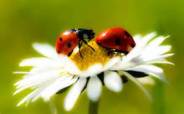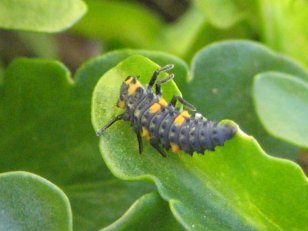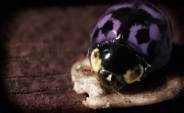Introducing the Ladybug , this tiny little flying beetle is not only a pretty accent to your garden, it's also good to have around! You know those pesky aphids and scale bugs that love to feast on the new growth of your plants ,deforming them, and how they love just ruining your roses? Well this pretty little beetle will eat them up, breakfast, lunch and dinner! The larva may not even look related, but they sure love eating those pests too.
, this tiny little flying beetle is not only a pretty accent to your garden, it's also good to have around! You know those pesky aphids and scale bugs that love to feast on the new growth of your plants ,deforming them, and how they love just ruining your roses? Well this pretty little beetle will eat them up, breakfast, lunch and dinner! The larva may not even look related, but they sure love eating those pests too.
The larva of a lady bug doesn't look much like its parents, instead, it looks almost like a soft small, black caterpillar with only the six small legs at the top of the body and small orange spots. They are found in the same places you would find the adults because they eat the same thing. In the two to three weeks they are in this stage they can eat up to 400 aphids! Next they go through a stage where they will attach themselves to a leaf and pupate. After about a week, they emerge as the Ladybug.
In North America, where I live in California, we are used to seeing the red ladybug with black spots, once I think I may have seen a Golden one. But they actually come in a few other colors; Blue, Purple, Pink, Brown, Green, Black, And Gray.
The Blue and Purple Ladybugs live in Hawaii
The Pink Lady Bugs live in live in North America, I have never seen one but it sure sounds pretty! Gray Ladybugs are known to live in Alabama in the United States.
There are also ladybugs that can be pests and actually eat your plants as well. If you decide you want the beneficial guys to live in your garden, they can be purchased online. When you purchase them online you know they will be the ladybugs you want.









No comments:
Post a Comment